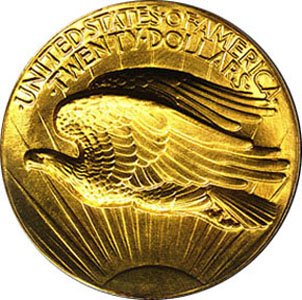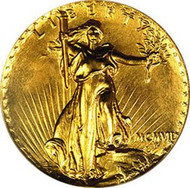The Numismatic Legacy of Augustus Saint-Gaudens
Posted by Bullion Shark on Jul 26th 2021
The Numismatic Legacy of Augustus Saint-Gaudens
Augustus St. Gaudens was an American master sculptor who embodied the American renaissance -- a period from the late 19th to early 20th century marked by a belief that the country was the natural heir to ancient Greece and Rome and the European renaissance.
He rose to become arguably the most famous artist in the United States towards the end of his life largely through his high-profile monumental sculptures. Those works were mostly public commissions for large monuments and statues like one of President Lincoln in Chicago or the one of Civil War General William T. Sherman in New York’s Central Park.
St. Gaudens also had an enormous numismatic legacy and is perhaps the greatest American coin designer primarily because of the $20 gold Double Eagle he created for the United States Mint, which is widely considered the most beautiful American coin and whose design continues to appear on the nation’s flagship gold bullion coin, the American Gold Eagle issued since 1986.
Born in Dublin, Ireland to a French father and an Irish mother, his family emigrated to the United States shortly after his birth. After competing his training, he eventually maintained art studios in both New York and Paris and mentored some of the greatest sculptors of his age who served as his assistants and later became legendary coin designers such as Adolph Weinman, James Earle Fraser and Bela Lyon Pratt.
Teddy Roosevelt
As for his numismatic legacy, it began with a medal he made for the inauguration committee for President Theodore Roosevelt in 1905 that pleased the president and led him to contact the artist to see if he could redesign our circulating coinage. Roosevelt disliked the artistry of the Barber silver coins, Morgan dollar and especially the gold coins by James Longacre of the time and wanted our coins to have the relief and artistry of Greek coins and to reflect the coming of age of the U.S.
As their partnership developed, Roosevelt gave Saint-Gaudens extensive freedom in his work. Both men admired the coinage of ancient Greece and believed that American coinage needed to be of a much higher aesthetic standard to reflect the nation’s prominence.
Saint-Gaudens worked from 1905 to 1907 redesigning the $20 and $10 gold coins and created patterns for a new cent and other coins before succumbing to cancer 1907, which means he never was able to see first-hand the fruits of his numismatic labors. His assistant Adolph Weinman had to finish the models for the coins, while Charles Barber, the mint’s chief engraver, had to modify his high-relief coin models to make them suitable for mass production.

St. Gaudens Double Eagle
His extraordinary design of Liberty striding towards the dawn of a new day is generally considered to be based on his statue of the Greek goddess of Victory, Nike, which appears next to a statue of Sherman on a horse on his famous monument in New York.
However, some scholars believe that while that monument inspired the famous St. Gaudens gold coin obverse design, his first model for Liberty was actually a young African-American woman named Hetty Anderson. The artist’s son Homer went to great lengths to expunge that information after his father’s death. But the final design of Liberty used on the coin does not appear to resemble Anderson and instead reflects the Greco-Roman imagery that St. Gaudens admired.
That is why developing his design Saint-Gaudens initially depicted Liberty with large wings as his statue of Victory in New York does to resemble the winged goddess Nike, but he decided to remove the wings and have her carrying a torch of enlightenment in her right hand and an olive branch of peace in her left hand.
In late 1907 20 pattern versions were struck of the artist’s original conception of the coin struck in amazing Ultra-High Relief with Roman numerals that required 11 strikes of the coin press and are major rarities today. Those patterns had to be modified by Barber by reducing their relief so they could be made in Iarger numbers, which resulted in December 1907 in the striking of 12,317 examples of the 1907 High-Relief $20 gold coin with Arabic numerals, which are also very rare and expensive coins today.
But those versions proved to be impractical for large-scale minting, so finally the relief was reduced again for the 1908 Double Eagles struck in two versions – with a without the motto, “In God We Trust” -- and was minted that way until 1933.
In 2009 former U.S. Mint Director Edmund Moy fulfilled St. Gaudens’ vision for a UHR version of his $20 gold coin accessible to regular collectors with a 1-ounce tribute struck with a smaller diameter because of the extensive relief, which many people consider the most beautiful modern U.S. collector coin.
American Gold Eagle
The 1985 legislation that created the American Silver and Gold Eagle bullion coin programs stipulated that the obverse of the new gold coin had to have “a design symbolic of Liberty” and Saint-Gaudens celebrated design was selected for that purpose. But modifications were made to it, most significantly in giving Lady Liberty a slimmer look compared to the original $20 gold coin design.
This year the Mint launched the type 2 2021 Gold Eagle with both a new reverse design of a close-up profile of the head of an eagle for the reverse to replace the family of eagle design used from 1986 to 2021 and also, as discussed here recently, restored much of the original design elements that were removed in 1986. Those include a more robust Liberty, reducing the numbers of stars around the inner rim back to 46 as they were in 1908 to reflect the number of states at the time plus other changes to the Capitol, torch and sun rays.
St. Gaudens $10 gold coin, or eagle, is also a favorite with collectors and is an unusual design because it shows Liberty wearing the headdress used by male Native American chiefs. It too debuted in 1907 in a high-relief pattern that had to be flattened for the coins issued from 1908 to 1933, which also have motto and no motto types.
Though the numismatic art of Saint-Gaudens reflects the aesthetic sensibilities of the early 20th century, his designs, especially the one for the gold Double Eagle, still seem timeless and modern, and his numismatic legacy will endure indefinitely on classic and modern American coinage.
News from the U.S. Mint
On July 22 the United States Mint announced that starting on August 9 it will begin selling through its network of bullion dealers the last 200,000 type 1 American Silver and the first 200,000 type 2 examples of that coin as well as the final 15,000 type 1 Gold Eagles and the first 15,000 type 2 Gold Eagles.
In addition, later this year to celebrate the 35th anniversary of both programs the Mint will hold a public auction for four special sets that will be limited to 500 each that will include pairs of type 1 and 2 examples of both coins that were personally struck by Director of the Mint, David J. Ryder.


